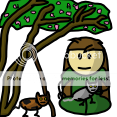Results 1 to 2 of 2
Thread: Book of Days
-
2007-01-22, 07:35 AM (ISO 8601)Dwarf in the Playground


- Join Date
- Jan 2007
- Location
- Gent, Belgium
- Gender

 Book of Days
Book of Days
In the Middle Ages, a “Book of Days” was a sort of illuminated day-planner and almanac that some of the more fortunate members of society carried with them. Noted in it were religious holidays, festivals, important events, astronomical information and similar information. In D&D, my Dungeon Master “Book of Days” serves the same purpose and more, and is designed to be the ultimate almanac for the day to day activities in my campaign world.
In D&D terms, my Book of Days is designed to be a calendar, weather and astronomy almanac, event planner, and story guide. I have guided my design over the years to serve as a rapid method of not only determining daily weather, random encounters, and noting events and dates, but also marking milestones to indicate the passage of time and location.
How to Make a Book of Days:
1) Material
2) Almanac Tab
a. Map
b. Time
c. Conversions
3) Weather Tab
4) Events
5) Calendar
d. Astronomy
e. Holy Days
f. Local festivals and Events
g. Character Birthdays
6) Story Sheets
h. Session
i. Players
j. Time markers (3)
k. Place markers (3)
1. Material- One can use any sort of day planner or calendar, but I find the ones with a sheet for each day are too expansive, and prefer they style where one month is spread across the two facing pages. Having a few extra pages in the front or back is good. Of course, calendars can also be made by hand.
2. Almanac tab- (a) I always include a few maps in the front for my quick reference, and often highlight “zones” for weather purposes. (b) I also include a sheet with the time scale and common names for the hours and the like. (c) It is also handy to add conversions for money on a page, along with unusual weights and measures and their equivalents (I have used bushels, etc), and once used a base 6 monetary system.
3. Weather Tab- This is simply a couple pages of weather matrices for a number of different regions or biomes, in different seasons. This makes for an easy reference and believable, dynamic weather.
4. Events Tab- I use this tab (always adjacent to the weather tab), to determine random events, including wandering monsters. Along with rolling the weather each day, I roll on the “events” chart in this tab. Generally the result is naught, but wandering monsters can occur- or some other event such as someone coming down with a cold, a piece of equipment breaking, random noises in the bush, finding an object on the ground, or a problem of minor annoyance. These are the kinds of things the “events” list is populated with.
5. Calendar- The calendar tab has astronomical notes upon it such as the moon(s) phases, and when the sun changes its zodiac sign. Holy days, holidays, birthdays, and important events are also noted
6. Story sheets- These are the final pages in the Book of Days, and are used to track game sessions. For each real world session played, the number and real world date are noted, the initials of the players who participated are noted, and unfilled “time” and “place” boxes are pre-drawn. The in-games days referenced on the calendar become marked with the number of the session listed (so if session 16 lasts six days of in-game time, those six days will be marked “16” on the calendar).
Markers: The “time” markers are filled in by the DM (me) on each occurrence of mentioning something indicating the time of day and/or year in the campaign world. For instance, through the course of one game they may become checked by 1) noting the “bustle of melon farmers who want to get their harvest in before the end of the season, as it grows warmer each day” 2) referring to the “mixed scent of fresh mud and fully blooming flowers”, and 3) describing a “flight of geese headed North overhead”. The characters should feel that indeed it is late Spring, and the world around them is in some kind of cycle.
The “place” markers serve the same purpose, except serve to indicate a location. These notes, when dropped in game, could refer to a local language or dialect, local crops or food and drink specialties, local weather and geology or geography, local color, flavor, or news.
As a DM this is my philosophy: as the seasons change, and as the characters travel, and events come and go, the players should feel that the world is alive and breathing, and has a grand life beyond them. I find the Book of Days and the “markers” of time and place help me create the proper story backdrop.
-
2007-01-22, 03:25 PM (ISO 8601)Titan in the Playground


- Join Date
- Feb 2006
- Location
- Kanagawa, Japan
- Gender

 Re: Book of Days
Re: Book of Days
Yeah, this is quite nice for a detailed and long term campaign. If you can email it out to your Players regularly, all the better.
It is a joyful thing indeed to hold intimate converse with a man after one’s own heart, chatting without reserve about things of interest or the fleeting topics of the world; but such, alas, are few and far between.
– Yoshida Kenko (1283-1350), Tsurezure-Gusa (1340)









 RSS Feeds:
RSS Feeds: 

